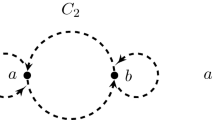Abstract
A new methodology for developing theories of action has recently emerged which provides means for formally evaluating the correctness of such theories. Yet, for a theory of action to qualify as a solution to the frame problem, not only does it need to produce correct inferences, but moreover, it needs to derive these inferences from a concise representation of the domain at hand. The new methodology however offers no means for assessing conciseness. Such a formal account of conciseness is developed in this paper. Combined with the existing criterion for correctness, our account of conciseness offers a framework where proposed solutions to the frame problem can be formally evaluated.
Similar content being viewed by others
References
Baker, A., ‘A simple solution to the Yale shooting problem’, in Proceedings of the International Conference on Principles of Knowledge Representation and Reasoning, pages 11-20, 1989.
Davis, E., Representations of Commonsense Knowledge, Morgan Kaufmann, 1990.
Genesereth, M. R., and N. J. Nilsson, Logical Foundations of Artificial Intelligence, Morgan Kaufmann, 1987.
Hanks, S., and D. McDermott, ‘Default reasoning, non-monotonic logics, and the frame problem’, in Proceedings of the National (U.S.A.) Conference on Artificial Intelligence, pages 328-333, 1986.
Hass, A. R., ‘The case for domain-specific frame axioms’, in Proceedings of the 1987 Workshop on the Frame Problem, 1987.
Kartha, G. N., ‘Two counterexamples related to baker's approach to the frame problem’, Artificial Intelligence 69:379-391, 1994.
Kartha, G. N., and V. Lifschitz, ‘Actions with indirect effects (preliminary report)’, in J. Doyle, E. Sandewall, and P. Torasso, editors, Proceedings of the Fourth International Conference on Principles of Knowledge Representation and Reasoning, pages 341-350, Morgan Kaufmann, 1994.
Lin, F., and Y. Shoham, ‘Provably correct theories of action (preliminary report)’, in Proceedings of the National (U.S.A.) Conference on Artificial Intelligence, pages 349-354, 1991.
Mccain, N., and H. Turner, ‘A causal theory of ramifications and qualifications’, in Proceedings of the Fourteenth International Joint Conference on Artificial Intelligence, pages 1978-1984, Morgan Kaufmann, 1995.
Mccarthy, J., ‘Circumscription — a form of non-monotonic reasoning’, Artificial Intelligence 13:27-39, 1980.
McCarthy, J., ‘Applications of circumscription to formalizing common sense knowledge’, Artificial Intelligence 28:89-116, 1986.
McCarthy, J., and P. Hayes, ‘Some philosophical problems from the standpoint of artificial intelligence’, Machine Intelligence 4:463-502, 1969.
Peppas, P., and W. Wobcke, ‘On the use of epistemic entrenchment in reasoning about action’, in B. Neumann, editor, Proceedings of the Tenth European Conference on Artificial Intelligence, pages 403-407, John Wiley and Sons, 1992, Vienna, Austria.
Sandewall, E., Features and Fluents, Oxford University Press, 1994.
Shanahan, M., Solving the Frame Problem, MIT Press, 1997.
Shoham, Y., Reasoning About Change: Time and Causation from the Standpoint of Artificial Intelligence, MIT Press, Cambridge, England, 1988.
Winslett, M., Updating Logical Databases, Cambridge University Press, 1990.
Author information
Authors and Affiliations
Rights and permissions
About this article
Cite this article
Peppas, P., Koutras, C.D. & Williams, MA. Prolegomena to Concise Theories of Action. Studia Logica 67, 403–418 (2001). https://doi.org/10.1023/A:1010516501232
Issue Date:
DOI: https://doi.org/10.1023/A:1010516501232




